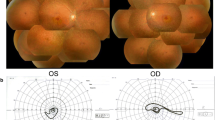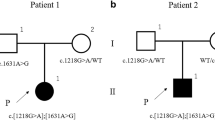Abstract
Background
Bardet–Biedl syndrome (BBS) is a rare autosomal recessive ciliopathy characterized by 6 primary features of rod-cone dystrophy, central obesity, polydactyly, cognitive impairment, hypogonadism and/or genitourinary malformations, and kidney abnormalities. At least 21 genes associated with BBS have been reported. To date, BBS associated with BBS12 variants has never been described in the Japanese population. We report a Japanese infant female with BBS with compound heterozygous BBS12 variants.
Methods
In addition to the pediatric examination, fundus photography, full-field electroretinogram(ffERG) and whole exome sequencing (WES) were underwent.
Results
The infant exhibited obesity, polydactyly, cognitive impairment, genitourinary malformations, and kidney dysfunction. At the age of 2 years, ffERG revealed severe reduction in both rod- and cone-mediated electroretinographic responses consistent with a severe form of rod-cone dystrophy, with minimal retinal abnormalities. WES revealed novel compound heterozygous BBS12 variants (c.591T > A, p.Tyr197* and c.1372dupA, p.Thr458Asnfs*5) in the infant. Her parents carried each of the variants, as confirmed by Sanger sequencing.
Conclusions
The current observations will contribute to an expanded understanding of genotype–phenotype associations in BBS12-associated BBS.




Similar content being viewed by others
Data availability
The data that support the findings of this report are available from the corresponding author, upon reasonable request. The data are not publicly available due to privacy or ethical restrictions.
References
Chandra B, Tung ML, Hsu Y, Scheetz T, Sheffield VC (2022) Retinal ciliopathies through the lens of Bardet-Biedl syndrome: past, present and future. Prog Retin Eye Res 89:101035. https://doi.org/10.1016/j.preteyeres.2021.101035
Stoetzel C, Muller J, Laurier V, Davis EE, Zaghloul NA, Vicaire S, Jacquelin C, Plewniak F, Leitch CC, Sarda P, Hamel C, de Ravel TJ, Lewis RA, Friederich E, Thibault C, Danse JM, Verloes A, Bonneau D, Katsanis N, Poch O, Mandel JL, Dollfus H (2007) Identification of a novel BBS gene (BBS12) highlights the major role of a vertebrate-specific branch of chaperonin-related proteins in Bardet-Biedl syndrome. Am J Hum Genet 80:1–11. https://doi.org/10.1086/510256
Niederlova V, Modrak M, Tsyklauri O, Huranova M, Stepanek O (2019) Meta-analysis of genotype-phenotype associations in Bardet-Biedl syndrome uncovers differences among causative genes. Hum Mutat 40:2068–2087. https://doi.org/10.1002/humu.23862
Hirano M, Satake W, Ihara K, Tsuge I, Kondo S, Saida K, Betsui H, Okubo K, Sakamoto H, Ueno S, Ikuno Y, Ishihara R, Iwahashi H, Ohishi M, Mano T, Yamashita T, Suzuki Y, Nakamura Y, Kusunoki S, Toda T (2015) The first nationwide survey and genetic analyses of Bardet-Biedl syndrome in Japan. PLoS One 10:e0136317. https://doi.org/10.1371/journal.pone.0136317
Hirano M, Satake W, Moriyama N, Saida K, Okamoto N, Cha PC, Suzuki Y, Kusunoki S, Toda T (2020) Bardet-Biedl syndrome and related disorders in Japan. J Hum Genet 65:847–853. https://doi.org/10.1038/s10038-020-0778-y
Robson AG, Frishman LJ, Grigg J, Hamilton R, Jeffrey BG, Kondo M, Li S, McCulloch DL (2022) ISCEV standard for full-field clinical electroretinography (2022 update). Doc Ophthalmol 144:165–177. https://doi.org/10.1007/s10633-022-09872-0
Hayashi T, Katagiri S, Kubota D, Mizobuchi K, Ishiuji Y, Asahina A, Kameya S, Nakano T (2021) The first Japanese family of CDH3-related hypotrichosis with juvenile macular dystrophy. Mol Genet Genomic Med 9:e1688. https://doi.org/10.1002/mgg3.1688
Mizobuchi K, Hayashi T, Oishi N, Kubota D, Kameya S, Higasa K, Futami T, Kondo H, Hosono K, Kurata K, Hotta Y, Yoshitake K, Iwata T, Matsuura T, Nakano T (2021) Genotype-phenotype correlations in RP1-associated retinal dystrophies: a multi-center cohort study in Japan. J Clin Med. https://doi.org/10.3390/jcm10112265
Hayashi T, Kondo H, Matsushita I, Mizobuchi K, Baba A, Iida K, Kubo H, Nakano T (2021) Homozygous single nucleotide duplication of SLC38A8 in autosomal recessive foveal hypoplasia: the first Japanese case report. Doc Ophthalmol 143:323–330. https://doi.org/10.1007/s10633-021-09842-y
Hayashi T, Mizobuchi K, Kameya S, Yoshitake K, Iwata T, Nakano T (2021) A new PDE6A missense variant p.Arg544Gln in rod-cone dystrophy. Doc Ophthalmol 143:107–114. https://doi.org/10.1007/s10633-021-09826-y
Tadaka S, Hishinuma E, Komaki S, Motoike IN, Kawashima J, Saigusa D, Inoue J, Takayama J, Okamura Y, Aoki Y, Shirota M, Otsuki A, Katsuoka F, Shimizu A, Tamiya G, Koshiba S, Sasaki M, Yamamoto M, Kinoshita K (2021) jMorp updates in 2020: large enhancement of multi-omics data resources on the general Japanese population. Nucleic Acids Res 49:D536–D544. https://doi.org/10.1093/nar/gkaa1034
Pereiro I, Valverde D, Pineiro-Gallego T, Baiget M, Borrego S, Ayuso C, Searby C, Nishimura D (2010) New mutations in BBS genes in small consanguineous families with Bardet-Biedl syndrome: detection of candidate regions by homozygosity mapping. Mol Vis 16:137–143
Abu-Safieh L, Al-Anazi S, Al-Abdi L, Hashem M, Alkuraya H, Alamr M, Sirelkhatim MO, Al-Hassnan Z, Alkuraya B, Mohamed JY, Al-Salem A, Alrashed M, Faqeih E, Softah A, Al-Hashem A, Wali S, Rahbeeni Z, Alsayed M, Khan AO, Al-Gazali L, Taschner PE, Al-Hazzaa S, Alkuraya FS (2012) In search of triallelism in Bardet-Biedl syndrome. Eur J Hum Genet 20:420–427. https://doi.org/10.1038/ejhg.2011.205
Pawlik B, Mir A, Iqbal H, Li Y, Nurnberg G, Becker C, Qamar R, Nurnberg P, Wollnik B (2010) A novel Familial BBS12 mutation associated with a mild phenotype: implications for clinical and molecular diagnostic strategies. Mol Syndromol 1:27–34. https://doi.org/10.1159/000276763
Kurata K, Hosono K, Hikoya A, Kato A, Saitsu H, Minoshima S, Ogata T, Hotta Y (2018) Clinical characteristics of a Japanese patient with Bardet-Biedl syndrome caused by BBS10 mutations. Jpn J Ophthalmol 62:458–466. https://doi.org/10.1007/s10384-018-0591-8
Katagiri S, Hosono K, Hayashi T, Murai N, Wake E, Miyata I, Mizobuchi K, Kurata K, Matsuura T, Nakano T, Hotta Y (2020) Novel biallelic splice-site BBS1 variants in Bardet-Biedle syndrome: a case report of the first Japanese patient. Doc Ophthalmol 141:77–88. https://doi.org/10.1007/s10633-020-09752-5
Acknowledgements
We thank the patient and her parents for their participation in this study. We also thank Prof. Sae Ochi (Department of Laboratory Medicine, The Jikei University School of Medicine) for assistance with genetic analysis.
Funding
This work was supported, in part, by the Grants-in-Aid for Scientific Research (KAKENHI) Grant Number 21K09756 (TH) and research funds from Santen (TH; Osaka, Japan), Alcon (TH; Tokyo, Japan), Johnson and Johnson Vision, AMO (TH; Tokyo, Japan), Daiichi Sankyo (TH; Tokyo, Japan), Chugai (TH; Tokyo, Japan), Mitsubishi Tanabe Pharma (TH; Osaka, Japan), Senju (TH; Osaka, Japan), Bayer (TH; Osaka, Japan), Kyowa Kirin (TH; Tokyo, Japan), Otsuka Pharma (TH; Tokyo, Japan), Kowa (TH; Aichi, Japan), Ritz medical (TH; Aichi, Japan), Uni-hite (TH; Kanagawa, Japan), and Kuribara (TH; Gunma, Japan).
Author information
Authors and Affiliations
Corresponding author
Ethics declarations
Conflict of interest
Takaaki Hayashi received research funds from Santen (Osaka, Japan), Alcon (Tokyo, Japan), Johnson and Johnson Vision, AMO (Tokyo, Japan), Daiichi Sankyo (Tokyo, Japan), Chugai (Tokyo, Japan), Mitsubishi Tanabe Pharma (Osaka, Japan), Senju (Osaka, Japan), Bayer (Osaka, Japan), Kyowa Kirin (Tokyo, Japan), Otsuka Pharma (Tokyo, Japan), Kowa (Aichi, Japan), Ritz medical (Aichi, Japan), Uni-hite (Kanagawa, Japan), and Kuribara (Gunma, Japan). The funders had no role in study design, data collection and analysis, decision to publish, or preparation of this manuscript.
Statement of human rights
All procedures performed in studies involving human participants were in accordance with the ethical standards of the institutional and/or national research committee and with the 1964 Declaration of Helsinki and its later amendments or comparable ethical standards.
Statement on the welfare of animals
This article does not contain any studies with animals performed by any of the authors.
Informed consent
Written informed consent was obtained from the patient's parents for publication of this case report.
Additional information
Publisher's Note
Springer Nature remains neutral with regard to jurisdictional claims in published maps and institutional affiliations.
Rights and permissions
Springer Nature or its licensor (e.g. a society or other partner) holds exclusive rights to this article under a publishing agreement with the author(s) or other rightsholder(s); author self-archiving of the accepted manuscript version of this article is solely governed by the terms of such publishing agreement and applicable law.
About this article
Cite this article
Morohashi, T., Hayashi, T., Mizobuchi, K. et al. Bardet–Biedl syndrome associated with novel compound heterozygous variants in BBS12 gene. Doc Ophthalmol 146, 165–171 (2023). https://doi.org/10.1007/s10633-022-09915-6
Received:
Accepted:
Published:
Issue Date:
DOI: https://doi.org/10.1007/s10633-022-09915-6




